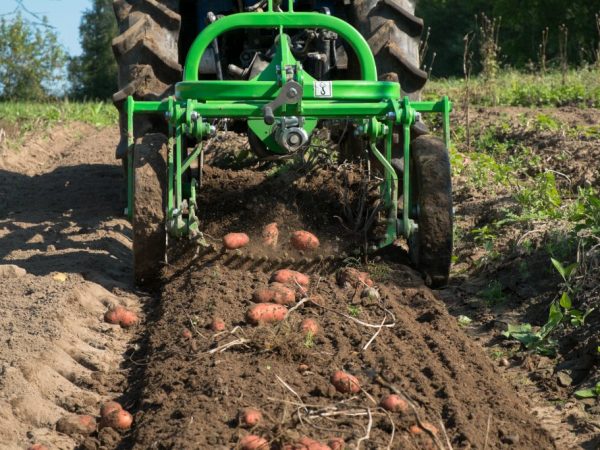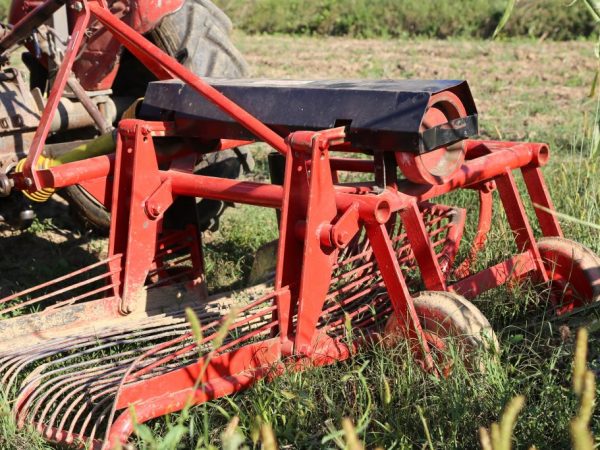How to make a potato digger for a mini tractor
The profitability of agricultural enterprises depends on many factors. Everything should be simplified and automated as much as possible. One of the most useful devices in farmland is a potato digger for a mini tractor.

Potato digger for mini tractor
The advantages of this technique are obvious. Its use allows you to reduce the time of harvesting, spend a minimum amount of effort.
Characteristics of the potato digger
Potato diggers completely replace human labor. With the help of such a device, the process of collecting root crops is automated. Despite the name, the devices can be used not only for potatoes, but also for other crops: carrots, beets, turnips, etc. They are of 2 types: single-row and double-row, and according to the fastening method - hinged.
Single row digger
A single-row digger is often used for walk-behind tractors and mini tractors, that is, agricultural equipment with an engine with a power of up to 5 kW. Its weight and dimensions are small. It can work with any domestic and foreign tractors: T 40, Scout T 25, MTZ 82, Belarus 132 N, Chuvashpiller 120, Shifeng f 240, etc. (the main thing is to choose the right model).
Double row digger
Two-row digger - attachments for large tractors, such as MTZ-80 (country of production - Belarus), Belarus 922, etc. In addition to design features, such devices have differences in price.
The price of a potato digger for a mini tractor is high, so farmers are forced to buy used devices or make them with their own hands.
Equipment of the KFT 2-01 brand from the well-known plant "Belarus" in the city of Smorgon (smorgon-tracktor.by) will cost the buyer $ 640-650. DTZ - 1 T of Ukrainian production costs less than $ 350, but these costs are incommensurate with a device that can be made by hand.
The main advantage of a potato digger for a mini tractor with your own hands is its cheapness. In addition, a person himself designs attachments and "adjusts" it to a tractor of domestic, Chinese or Japanese production. In addition, it does not matter where the person is: in Irkutsk, Astrakhan or on the Black Sea coast. Taking care of the material, drawings and welding machine, you can build a planter in a matter of hours.
Types of diggers
Purchased
Production diggers for potatoes for a mini tractor differ in design from home-made devices. The most common types of purchased devices:
- Rumbling (vibrating). After grabbing the potato, it falls on the table, which gives in to vibration, shaking off soil particles.
- Conveyor. The design of the device is the same as that of a roaring digger, but a grate is installed on such a device instead of a table.
- Fan-shaped. By the principle of operation, they have similar features with the vibration analogue. It is used more often not on mini tractors, but on walk-behind tractors. There are no moving elements in its design.
Homemade
A homemade digger in terms of functionality is inferior to the original products of tractor factories, it will be enough for private property. The main thing is to get the blueprints and find the necessary materials. The very process of assembling the device will not take much time. The easiest option is to make a lancet digger. By design, it is a concave shovel with long rods.
The disadvantage of harvesting potatoes with such a device is inconvenience. A person has to make fewer movements than when working with a conventional shovel. For a mini tractor, such a device is not suitable. This is a common tool change that works well in small vegetable gardens. It is difficult to dig up 1-2 km of planted beds.
A single-row mounted potato digger for a mini tractor, which you can do yourself, should be as strong and reliable as possible. The easiest way to assemble is a vibrating unit, the frame of which is made of metal corners 60 x 40 or 50 x 50. A grid can be used as a table for potatoes.
Training

We make the structure
To start working on designing a homemade digger, you need to understand the principle of operation of its individual elements: this will make it easier to cope with the task of creating equipment. The frame is the base to which the elements are attached. The grate is the part of the apparatus on which the tubers dump the remaining soil. A ploughshare is a plow, and a transport hub is a piece of equipment that is responsible for moving the machine. It can include not only wheels, but also a chain, sprockets, discs and bearings.
Materials and tools
All work should be carried out according to drawings and sketches. Before starting work, you should prepare:
- metal corners 60 x 40;
- channel No. 8;
- sheet metal (from 7 mm thick);
- fittings (with a diameter of 10 mm);
- wheels;
- metal pipes (racks);
- conveyor belt (if necessary).
It is also important to prepare the welding machine and the bolts for attaching the share. Using a metal saw, gas cutter or grinder, pipes, sheet metal and a channel are sawn off according to the dimensions indicated in the drawing.
Making a potato digger
A one-row homemade potato harvester should be as stable and durable as possible. Any errors in the manufacture of the device can cause accidents and breakdowns, therefore it is better to assemble the device for people with technical education and the skills of a cutter and welder.
The procedure for making a potato digger is performed step by step:
- The frame of their prepared pipes is welded.
- A channel is welded to the lower part of the frame, on which the regulating units will be installed later.
- 3 vertical posts are welded to the frame with a distance from each other (support for the lattice), which are connected with the remains of the channel.
- A ploughshare is welded or bolted to the supports.
Further actions are associated with the working part of the vibration apparatus - the grid. It must be welded from prepared reinforcement and sheet metal strips. When finished, it should be connected to the shaft. When the mechanism is ready, it is bolted to the already welded digger legs.
The next procedure is making a share. It can be made both from sheet metal strips and from a metal pipe with a diameter of 24-25 cm. It is necessary to give the workpiece the shape of a ploughshare, having previously cut off the pipe ring in one place. Next, the workpiece is sharpened and bolted to the lattice.
The assembly of the device is completed with the installation of the chassis and the installation of fasteners connecting the digger with a minitractor. The chassis is made at the request of the designer himself. One shaft with bearings should be fixed to the frame, or 2 separate hubs should be made. It is better to take automobile wheels (with tractor protectors). They will calmly transfer the mileage of up to 1000 km.
Tips from the masters
Homemade potato diggers are popular not only among tractor owners, but also among those who are used to using walk-behind tractors. Those people who have already faced the problems of designing such devices argue that it is very difficult to do everything right. It is better to use the experience of predecessor foremen who advise farmers:
- Make the device only from durable thick-walled metal. Such a device carries heavy loads. All knots must be tightly connected and secure.
- Use more bolted connections than welds. Welding, despite its accuracy and availability, is inferior in its reliability to bolts and nuts. In addition, vibration can cause the weld to crack. And the bolts can always be tightened.
- Have multiple sets of knives. The ploughshare made of sheet metal or pipe not only “blunts”, but also breaks. These problems are especially common when working with hard ground.
Experts also note that all work is best done with an assistant. It is inconvenient and difficult for one person to assemble a digger, due to the fact that most of the parts are made of metal and are heavy.
Conclusion
Homemade potato diggers are an economical way to automate agricultural work. But, the design features of the device may differ slightly from specialized devices that can be purchased in the store. It all depends on the skills of the master himself. Sometimes, the creations of farmers and their technical thinking lead to the emergence of mechanisms that surpass any commercial counterparts.


